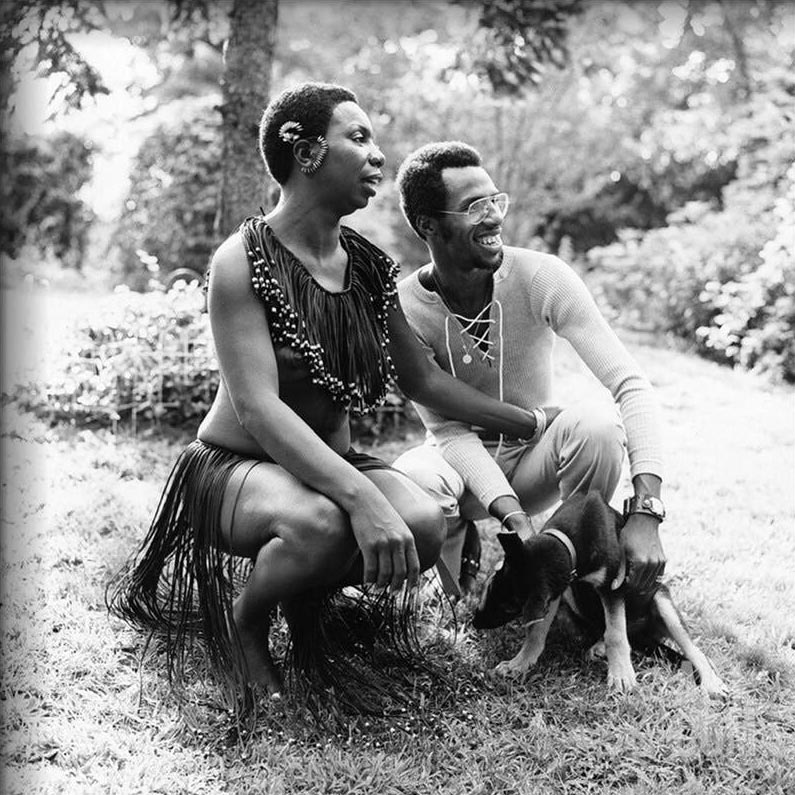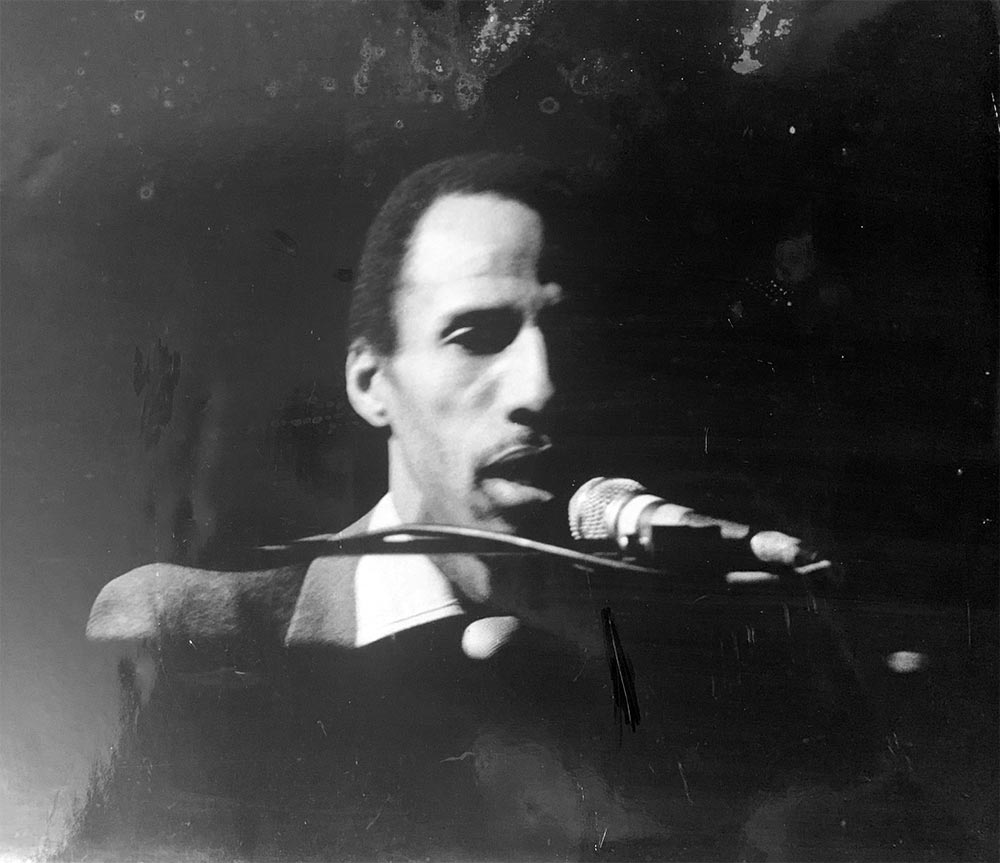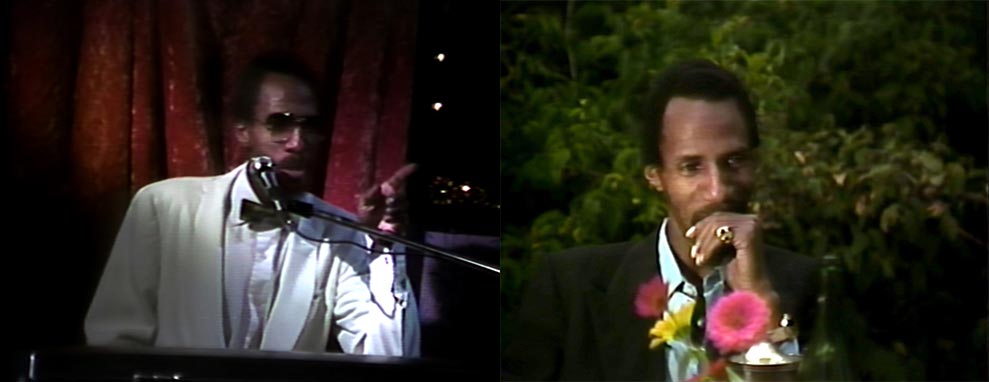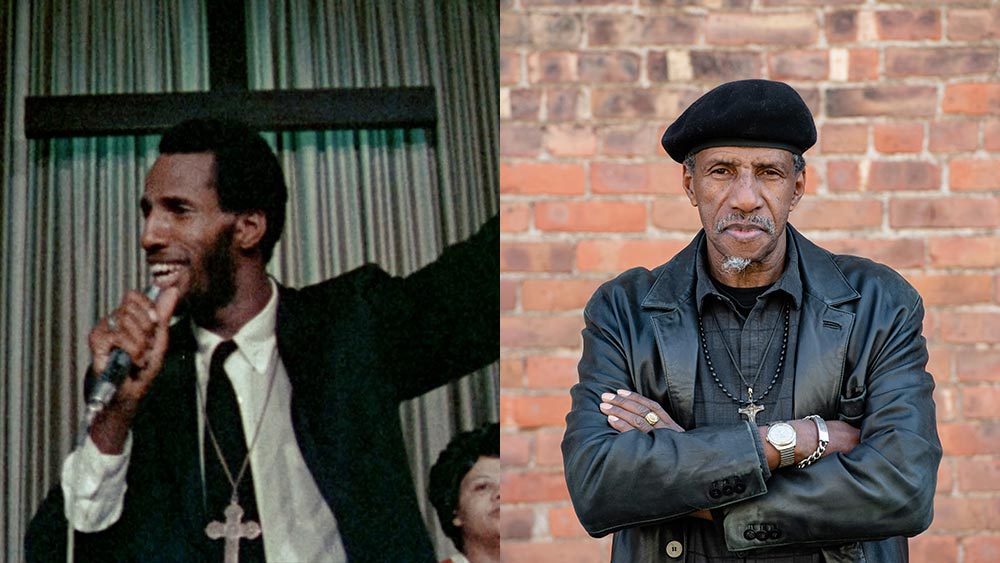My first experience of composer and actor Sam Waymon was through the film Ganja & Hess (1973). After a recent viewing, I became interested in director Bill Gunn and started following related accounts on Instagram, including Dr. Waymon’s. I reached out to see if he’d be up for an interview. We spoke over the phone while I was in New York City and he in Nyack, where he once shared a creative household with Gunn.
We talked about his family growing up, including his sister, Nina Simone, née Eunice Waymon (whenever she’d call, she’d have his music playing in the background), and his activism. Much of the interview focused on Waymon’s film partnerships with Gunn, a director, actor, novelist and playwright.
This Saturday, June 5, Artists Space opens “Till They Listen: Bill Gunn Directs America,” an exhibition of archival materials from Gunn’s interdisciplinary output. There will be public programs, screenings with Maysles Cinema, Light Industry and the Luminal Theater, as well as a streamed performance by Waymon on June 8. He will play live music composed for the Ganja & Hess soundtrack and the theatrical production of Black Picture Show.
Stephanie LaCava: To begin, can you talk a little about your upbringing in Tryon, North Carolina, and how it informed your life and practice?
Sam Waymon: That’s easy. Tryon is right off the base of the Blue Ridge Mountains. It borders South Carolina, and it’s also horse country. A lot of Europeans come in the Spring and Summer, open up their summer houses, and then go back in the wintertime. So, you had this cross-section of different countries mixed in with the Americans, and it provided a “potpourri” of cultures and, of course, racism was rampant.
You had the KKK, you had the White Citizens’ Councils, you had bigotry. I grew up in that environment, where we had to walk on the other side of the street if we saw white people coming. We had the colored fountains and the white fountains. We couldn't go into the pharmacy to get milkshakes or anything until the white folks left. We had to sit upstairs in the balcony in the movie theater, because Black people were not allowed downstairs. We had our own separate entrance. All the usual stereotypical racist attitudes you have seen on television and in news footage, that was real — very real.
Tell me about your faith and experiences in the church as a young man.
What was interesting about Tryon is that even though we had segregation in the churches, the white church would visit the Black church every other Sunday. Or the white church would visit the Black church. We got along well when it came to religious practices and services. That was nice. Also Black school children would play white school children when it came to sports. That was interesting, because the kids always got along.
We were poor, but we didn’t know we were poor. We had food on the table, we had clothes, we were clean, we were obedient children. We didn’t get in trouble that much — not much, but a little bit. [Laughs] We associated with different classes of people. My mother was a minister — the pastor — in Tryon. She was a very elegant, sophisticated woman. When she would stand behind the podium in her robe, she commanded the room. She was fascinating. But in the Methodist religion down there, bishops said that women were forbidden to be pastors. She didn’t care about that at all.
You were the baby of the family, three brothers and four sisters?
Yes, my siblings had already left the house when I followed my mother on assignments to other churches. I enjoyed it. We were close. I went to Lane College, which is a church-supported college in Jackson, Tennessee. She had to work two jobs to put me there. I think the most interesting thing is that all eight of us could play the piano. All eight of us could sing, and my mom and dad. When it came for Christmas and Thanksgiving, you can imagine, it was, “Who’s gonna play the piano?”
Tell me how you met your longtime collaborator Bill Gunn?
I was writing and performing all over the world. And then I met Bill at Film Forum down in the city.
At the movie theater!
Yes. He knew who I was. He loved my sister. At that point she was Nina Simone, of course. No one dared call her Eunice but me. When I called her Eunice it really rattled her because I reminded her of our father. It was, "What did I do now, Dad?” I lived with Eunice in Mount Vernon for a long time, right around the corner from Malcom X and Betty Shabazz. They were our friends and would come around and visit us a lot. Then I moved to Nyack. Bill and I bought a house together, the old Ben Hecht estate. That was the beginning of our partnership.

I read some great stories about people who came around the house…
I think the most enjoyable ones were the ones with Jimmy Baldwin.
Tell me about James Baldwin. I can’t call him Jimmy. Only you can call him Jimmy, just like only you can call Nina Eunice. [Laughs]
He was an affable man. He was obviously a brilliant genius of a writer and a poet. He was a comedian. He was really a lot of fun. Jimmy would come to the house and stay for the weekend. He and Toni Morrison, sometimes. We were right on the river. We had our own private beach. This was high living. [Laughs] We had this old house that was built in 1730. I’m not bragging, just stating facts. It had all these rooms and so forth — a wine cellar, a gym, a pool, apple orchards. With Jimmy, we would sit outside on the lawn by the pool and just tell all these wonderful stories and we would talk about civil rights. We talked about marching, about his books.
What was it like to live with someone who you collaborate with?
It was a very creative house. Because Bill was a writer he had to write at certain hours, a certain time of the day.
What time of day?
Definitely in the mornings, and in the afternoons. One of the things that allowed us to live together was that he had his wing and I had mine. I had my piano in my music room. I would write early in the morning and he couldn't hear me. I couldn’t hear him, because the house was so big. It was a huge house, fifteen or eighteen rooms.
There's no such thing as a typical day. The days went the way they were supposed to go creatively. I would do a lot of writing downstairs, and so would he. He would be writing a script or pages on his books. Because I went to school for business, I could type very fast and very well. I ended up typing almost everything for him. I proofread everything he wrote. And he would ask for my opinion.
Which is your favorite of Gunn’s works?
All the Rest Have Died. That and, of course, Black Picture Show. As you know, I wrote the music to all three of the plays. There were favorites — plural. I loved Black Picture Show, Rhinestone Sharecropping and The Forbidden City. And definitely his book, All the Rest Have Died.
How did you go about scoring Ganja & Hess?
I ended up being very good at writing music to the spoken word. I was not only a
songwriter, I was a composer. To be a composer is different from being a songwriter. And as you can imagine, a composer has to feel the language, has to feel for the spoken word. That's how I was able to score Black Picture Show and Rhinestone Sharecropping and Ganja & Hess. Because I love language. And to me, language was the same as musical notes.
I wrote the score as the film was being shot. I was on set all the time, and I play one of the roles in the film. I was there even after we would shoot my scenes. The tone and the quality of the music was not to outshine the film, it was to compliment the visuals. Bill wanted the music to not be intrusive, but inclusive. This was a Black film. Back in the 70s, there had never been a film like it. It was not a shoot-’em-up kind of gangster drug-related film. The music couldn't be like that either. It had to be as sophisticated as the film was. And if anybody knows Bill Gunn, he’s a very elegant, sophisticated man. He writes like that. So the music had to be like that.

And what about the process for a play, like Black Picture Show?
Just to give you an example, when I met with the late Joe Papp, he knew what he wanted, but he also loved Bill and I. He fell in love with Black Picture Show and committed to producing that for Broadway, a month after he read it. He was a beautiful man, a beautiful person. He had such great ideas. Very stubborn. I was able to live with the play from the very beginning of its conception, because I was around Bill when he wrote it. I made sure that I made every rehearsal, even if I didn’t have to participate. The process is that if I lived the play while it was in rehearsals, I got a sense of the characters, their emotional selves. They were real.
I saw those characters as notes on a music sheet of paper. I envisioned the movements of the actors on stage going back and forth as though they were on a musical staff. That’s the way it works. Music is one of the characters in film. Bill would say, “I’m not a musician, you are. I’m a writer.” And we respected each other in that vein. And that's how we were able to form such a tight-knit relationship between the music and the spoken word. I gotta tell you, if I didn't like the way he wrote, I couldn’t have written good music. I love his style. I love his vision. The way that he would create drama and tension with his characters. I love that for the music. I was able to feel that.
I heard that your monologue in Personal Problems was the only thing from the initial 30-minute version that transferred to the final three hour cut.
Yes, and you’re also talking about me singing the song to Johnnie Mae. Vertamae Grosvenor’s character was a very troubled woman in a very emotional marriage. I played her lover. I was the one she had to come to a comfort package outside of the marriage. I wanted to make her feel her womanhood. I wanted to make her feel wanted, loved and needed outside of conflict. She loved my singing, my sensitivity. I mean in character, in terms of the movie.
So she came over and I knew what she wanted. She needed to be touched, her heart and her femaleness. She needed some tenderness. That’s why I sang that song, “Down on Me."
When I sang that song, I looked up and she was crying. This was not rehearsed. This was real. She didn’t rehearse crying. No, no, no. I couldn’t do that song, but once, really, I felt it. I was in love with her and she knew that, the character. We loved each other, but also I respected her boundaries. I respected the fact that she was married. She had a husband. She was in a relationship and you have to be careful with stuff like that. I wanted to offer her some sense of love and understanding and appreciation for who she was. I felt that song was the catalyst for that.

Did you talk at length to Bill about that?
We did talk about what songs I would sing. He’d heard me play that song downstairs in the house. He said, “Oh, I think that song will work.”
I played it for Vertamae at a rehearsal and she said, “Oh, that’s perfect.”
Talk to me about the perils of trying to create within the Hollywood system.
The driving force behind the collaboration of making Ganja & Hess was independence.
We're going to follow our hearts. We're going to follow our dream. We're going to follow our artistic destinies. We were going to make a film that people of color, Black folks at that time, would not have this opportunity to do again, even though the producers wanted a Black exploitation film. Obviously, we didn't make that.
We said okay, we only have $350,000. So Bill said, “No, wait a moment, Let’s do our thing.”
We knew that was completely contrary to what was popular out there in the theaters. We knew Hollywood would probably not like it, but we didn't give a hoot at all. We had to do what was right for us. And I think the way you can leave a legacy is to follow your own path. Follow your own Carpet Ride. Ganja & Hess was my first major score for a film, but the stylistic process was the same. It was emotional, sad, lonely, loving. It was sensual.
Tell me about Gunn casting you in the preacher role.
When Bill was writing Ganja & Hess, he came to me and said, “I know you come from the South and from a religious family, would you play the preacher?” He knew I was a country gentleman, I knew horses. I played not only the preacher, but the stable man and the driver.
Did you look to your mother as a pastor while you were preparing?
I was brought up in the church. Listen, my sisters were all pastors. The only family members that were not ministers were Frances and Eunice. I was surrounded by church members. I would say that my mother was probably my role model. Yes, I could say that. But having played in church choirs, I’m familiar with the process and the glorification of spirituality. Bill said to me, “I’m not from the church, but you are. I’m gonna leave that church scene up to you. You know the choir, the congregation, this and that.”
So, you art directed it and starred in the church scene?
Yes, and by the way, that was one take.
No!?
That whole church scene was one take. There’s no way you can do that twice or three times.
I wanted to ask about that scene where you see the Nina Simone record.
Oh, you noticed it. Bill threw that in. He said, “Is it alright if I throw in your sister’s album?” He put it in because Hess was a Black archaeologist, right? He loves jazz. Bill really did that for me.
Tell me more about writing the score for Ganja & Hess.
I had no intentions of writing like Curtis Mayfield when he wrote Super Fly. Now, Curtis Mayfield, who was a friend of mine, wrote a fantastic, beautiful score. But I was not writing a Curtis Mayfield-type score. Because the movie was not a Superfly movie. As you know, I used a lot of African sounds. The theme of the music for Ganja & Hess was acoustic. That’s why I used a lot of horns, I used a guitar. That’s why I'm using a piano in the love scene. That’s when they were making love and Bill deliberately had all those rhinestones gleaming particles on Ganja’s body so that she looks beautiful. The music had to reflect that. You heard all those chimes and bells and sounds in the bathroom scene. It’s the same thing when Hess is dying in the shadow of the cross. That screaming, harrowing sound that you hear…
I can still hear that sound. What is that?
That’s me having an out-of-body experience.
What?
When it got to the scene, we needed something to go over Hess dying in the shadow of the cross. Stephanie, I couldn't come up with any sound. I thought, what kind of instrument is going to make the public think that he's dying? I told Bill and the crew I was going to lock myself up in the music room with the piano in Nyack for two or three days. They ran cables under the door with a recording machine. I said, “I do not want to be disturbed. Leave me alone. When I want something to eat, I knock on the door, but get out.”
The first day, I had an out-of-body experience and it scared me to death. It scared me tremendously, because I saw myself floating around. I was having nightmares. The second day, I had a big one, an awful one, really emotional and dramatic. I was screaming and screaming and hollering and I saw myself in the ceiling. I saw myself come at me. That was recorded on tape. After it was over, I was exhausted and I knocked on the door and I said, “I’m done.”
And they came to the door, and they said, “Oh, you look awful.” Bill said, “You look terrible.” I said, “I feel awful.” Bill said, “Sam, we got it.” I said, “What are you talking about?” He said, “We got it, your screaming. We got your out-of-body experience.” I said, “You got that on tape?” He said yes and gave it to the editor.
You didn’t know they were recording?
I did know that they had turned it off at some point, but I didn't know they turned it back on. I was in a different frame of mind, I was not concerned with the recording. I was concerned with candles and incense. I didn't take any drugs or anything. I was just involved with imagining myself dying. I had to try and translate what the soul would sound like in distress, on its last voyage.
I said, “I don’t want to hear it until Victor [the editor] gets it.” The editing office was down in the city on Broadway, 7th Avenue and 42nd Street. Victor calls me and says, “Sam, I want you to hear what I put in over the scene.” Well, he played it for me and I was astounded.
Header photograph of Sam Waymon by Ken Goodman, 2021.



